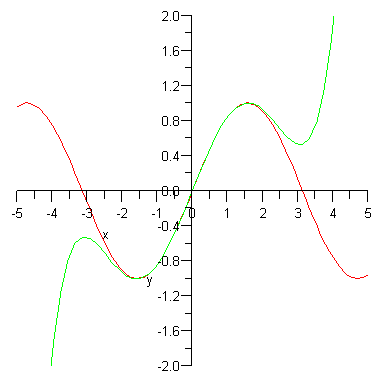Prime equals triple prime?
 f
′
(
x
)
=
f
′
′
′
(
x
)
f
′
(
x
)
=
f
′
′
′
(
x
)
For some infinitely differentiable function f ( x ) , it satisfies the above equation. Given the initial conditions
f ( 1 ) = 6 , f ′ ( 1 ) = 5 , f ′ ′ ( 1 ) = − 3
What is the value of f ( ln ( 4 2 ) ) ?
Details and Assumptions
f ′ ( k ) , f ′ ′ ( k ) , f ′ ′ ′ ( k ) denote the first, second, and third derivative of f ( x ) at x = k respectively.
Image Credit: Wikimedia Taylor Series
The answer is 24.192.
This section requires Javascript.
You are seeing this because something didn't load right. We suggest you, (a) try
refreshing the page, (b) enabling javascript if it is disabled on your browser and,
finally, (c)
loading the
non-javascript version of this page
. We're sorry about the hassle.
2 solutions
Can't we do
f ( x ) = n = 0 ∑ ∞ n ! ( x − 1 ) n f ( n ) ( 1 ) (Taylor series of f ) = 6 + 5 sin ( x − 1 ) − ( 3 cos ( x − 1 ) − 3 ) = 5 sin ( x − 1 ) − 3 cos ( x − 1 ) + 9
Log in to reply
This would yield f ′ ( x ) = − f ′ ′ ′ ( x ) instead. Perhaps a similar question can be based on your function. :)
Log in to reply
Yup, forgot that series expansion for sin and cos had alternating signs ;-;
Still, your method works, Comrade, mutatis mutandis ... just make the sine and cos hyperbolic. Very elegant method indeed!
You find f ( x ) = f ( 1 ) + sinh ( x − 1 ) f ′ ( 1 ) + ( cosh ( x − 1 ) − 1 ) f ′ ′ ( 1 )
Log in to reply
why do you write comrade everywhere ?? is it so to sound cool or something like that ??
Assume that f ( x ) takes the form of f ( x ) = A e k x + B e − k x + C , then we have:
⎩ ⎪ ⎪ ⎪ ⎨ ⎪ ⎪ ⎪ ⎧ f ( x ) f ′ ( x ) f ′ ′ ( x ) f ′ ′ ′ ( x ) = A e k x = A k e k x = A k 2 e k x = A k 3 e k x + B e − k x − B k e − k x + B k 2 e − k x − B k 3 e − k x + C . . . ( 1 ) . . . ( 2 ) . . . ( 3 ) . . . ( 4 )
For f ′ ( x ) = f ′ ′ ′ ( x ) ⇒ k = 1 .
Therefore:
⎩ ⎪ ⎨ ⎪ ⎧ f ( 1 ) f ′ ( 1 ) f ′ ′ ( 1 ) = A e + B e − 1 + C = A e − B e − 1 = A e + B e − 1 = 6 = 5 = − 3 . . . ( 1 a ) . . . ( 2 a ) . . . ( 3 a )
⎩ ⎪ ⎨ ⎪ ⎧ E q . 2 a + E q . 3 : E q . 2 a : E q . 1 a + E q . 3 a : 2 A e = 2 1 − B e − 1 = 5 C = 6 − ( − 3 ) ⇒ A = e − 1 ⇒ B = − 4 e ⇒ C = 9
⇒ f ( x ) = e x − 1 − 4 e − ( x − 1 ) + 9
⇒ f ( ln ( 4 2 ) ) = e 4 2 − 4 2 4 e + 9 = 2 4 . 1 9 2
Integrate f ′ ( x ) = f ′ ′ ′ ( x ) to see f ( x ) = f ′ ′ ( x ) + C The solution to the differential equation f ( x ) = f ′ ′ ( x ) is well known to be f ( x ) = A × e x + B × e − x , but if you want a proof, I recommend studying second order homogeneous differential equations with constant coefficients. Now the solution to our original equation is the same as this one, but with an additional constant of integration. Therefore the solution is of the form f ( x ) = A e x + B e − x + C You can find the first and second derivatives of this function, then set up a system of equations using the given values in the problem to solve for the constants. You should find f ( x ) = e 1 × e x − 4 e × e − x + 9 Substitute x = ln ( 4 2 ) . f ( ln ( 4 2 ) ) ≈ 2 4 . 1 9 2